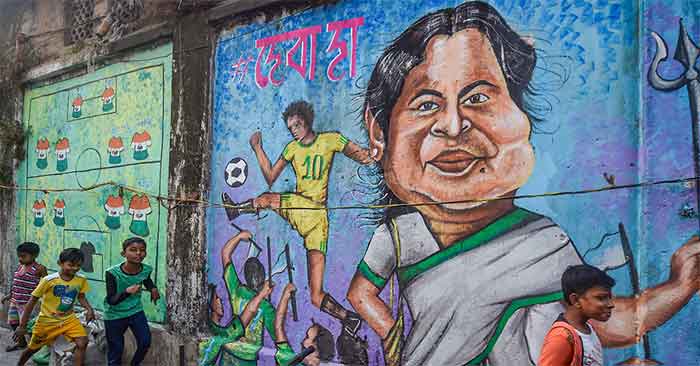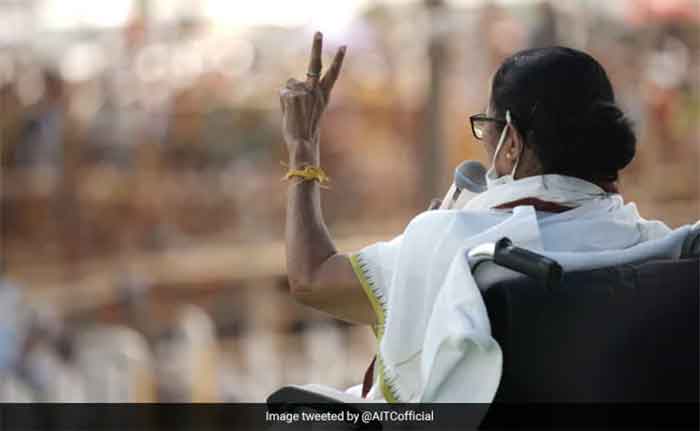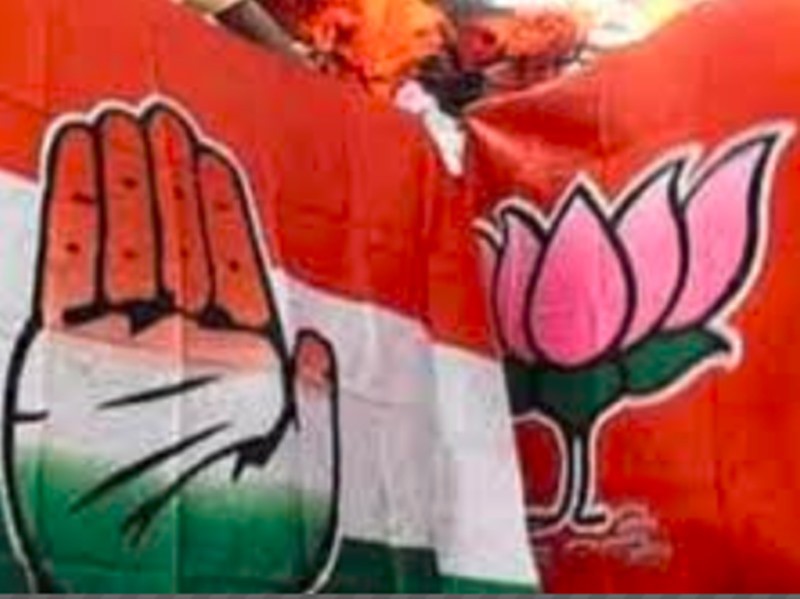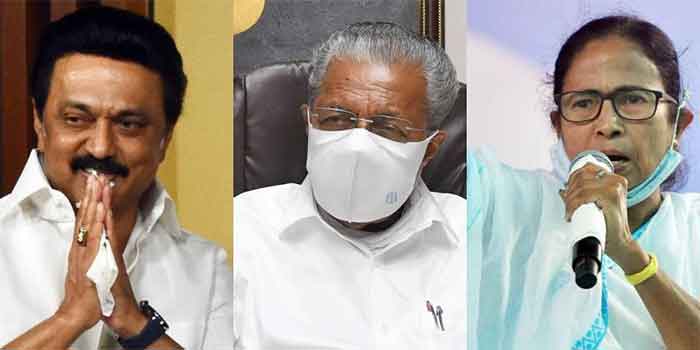
An irony it may seem, but it is a fact. The ruling Trinamool Congress (TMC) supremo Mamata Banerjee—who successfully steered her party to power in West Bengal for the third time in a row—lost her battle at Nandigram by 1700 votes to her erstwhile lieutenant Shubhendu Adhikari who defected to the saffron party before the elections. The TMC has demanded recounting pointing to manipulations of EVMs and the decision on the complaint is pending. The party won about three fourths of the seats and garnered nearly 50 per cent of the polled votes, the highest ever by the party in this eastern state bordering Bangladesh and defeated its mighty opponent, the BJP which rules India and many states of the country. She has come out as an anti-BJP crusader capable of halting the winning spree of the saffron party.
When Mamata was claiming in election rallies that her party would win over 200 seats, many political observers took it as campaign rhetoric. But the party won as many as 214 seats out of 292 went in polls. Similarly, union home minister Amit Shah’s claim of BJP grabbing 200 plus seats was also not taken seriously either. But they thought that there would be a neck-to-neck contest between the TMC and the BJP, while the Sanjukta Morcha comprising the Left parties, Congress and their newly found ally the Indian Secular Front, playing the third child of a goat would finish as a very distant third.
The saffron party mobilized all its might, money and muscle power to dethrone the lone woman chief minister of an Indian state. The prime minister, union home and other ministers as well as chief ministers of BJP-ruled states along with the BJP president shuttled like daily passengers to this state by chartered planes to ensure their victory. Around 130 TMC MLAs and leaders defected from the party considering it a sinking ship. A union minister and a number of BJP MPs from West Bengal were put into the fray. The BJP ferried huge number of Rashtriya Swayamsevak Sangh (RSS) cadres from other states to support and gear up their election machinery. The eight-phase election helped the party to shift its cadres from one area to the other. All this might have created some illusions among the political observers.
Despite all such efforts the BJP ended up with only 76 seats. However, nobody ever thought that the Sanjukta Morcha will be washed away. All of the Morcha candidates lost (and most of them had to forfeit their deposits), barring one representing the ISF. What a pity! This is for the first time in the post-independent history of the state that there will be no representation of the Left and the Congress in West Bengal Assembly. This will have a long lasting bearing on the state’s political and social life.
Why the much-hyped Modi-Shah duo failed to deliver while Mamata succeeded? First, the duo had put all their efforts to polarize the election on communal and cast lines through social engineering.
They had a clear arithmetic in their mind. The people of the state suffered most because of the partition and around 27 per cent population of the state are Muslims. So, the duo thought that it would be easy to mobilize the Hindu majority by playing the communal card and accusing the TMC of Muslim appeasement. They, in effect, tried to fool the Bengalis. A simple arithmetic shows that playing a Hindu (the majority) card is far more remunerative than playing a minority card. However, the strategy had a limited success. The duo perhaps failed to realize that the people of Bengal were, on the whole, never been diehard communal. The people of both the communities fought together successfully to stall Lord Curzon’s effort in 1906 to divide the erstwhile Bengal on communal lines. Since independence, the state never saw any major communal riots as was witnessed in many other Indian states, including Gujarat, Delhi and UP. Through social engineering they tried to woo scheduled castes (23 per cent of the total population) and scheduled tribes (around 6 per cent). This social engineering has perhaps paid the saffron party some dividend in a number of districts where SCs, the Matuas and STs are strong in numbers. However, in two Muslim dominated districts like Maldah and Murshidabad districts, where the Congress and the Lefts had considerable influence, the Muslim voters shifted their allegiances to the TMC almost en masse in order to defeat the BJP, while a huge chunk of the Hindu votes went to the saffron party.
Second, the BJP as well as the Morcha were harping on some misdeeds like appropriating cut money and mismanaging the Amphan disaster by some local TMC workers did not fetch the desired result. The TMC swept the Amphan-affected South 24 Parganas and the Sunderban areas of the North 24 Parganas districts. Many TMC workers accused of appropriation were embraced by the BJP and were even given tickets to contest in the elections. This gave a wrong signal to the electorate and most of the jersey changers lost. The BJP accused the state government of inapt handling of Covid pandemic. Initially this campaign had some impact on the electorate. But the second and more intense wave of Corona exposed the utter failure of the Modi administration as well as its failure to stop the Kumbha Mela (which had a severe impact on the spread of Corona) had finally turned the electorate against the BJP. The TMC’s success in the Corona affected districts like Kolkata and the adjoining North 24 Parganas, Howrah and Hoogly points to that.
Third, both the BJP and the Morcha failed to recognize many pro-people measures and schemes like Kanyashree and Swastha Sathi undertaken and implemented by the TMC government and their impact on the common men, particularly on the poor, the lower middle class as well as on the women. These programmes along with sincere implementation of the National Rural Employment Guarantee Scheme had also helped draw the rural poor to the TMC’s side considerably. There was an anti-BJP undercurrent, too. Many believe that the BJP promises, but does not deliver, while Didi, as Mamata is popularly known, delivers what she promises.
The present observer found interesting information while talking to a Hindu fruit vendor who sells fruit in a nearby railway station and a supporter of the Left. He said, “I support the Lefts. But they are not going to win this time. The BJP, on the other hand, is about to sell the stations to the outsiders and we will be pushed out of the station and of the business. So, I have to think over.” The message is loud and clear.
Fourth, the TMC government had done well in developing and expanding rural infrastructure like road and irrigation. However, the opposition failed to read its impact on agricultural production and income generation of the rural population. The growth in agriculture, poultry, fish and milk production during the last decade (2010-2919) was considerably higher than the national average.
Fifth, the way the BJP leaders including the prime minister and home minister used abusive words like ‘Oh Didi, Oh Didi’ against Mamata violating all civilized codes of conduct during the entire political campaigning has had very negative impact on the electorate, on the women voters in particular. Majority of the women voters stood by Mamata considering her a victim of male chauvinism. One may wonder, why then she faced defeat at Nandigram? There are complains that the BJP used money power to woo, in other words, to bribe a large chunk of women voters in their favour to defeat Mamata.
Mamata played successfully the Bengal’s Asmita (pride) card to her party’s favour. The BJP brought campaigners and large number of RSS workers from other states. These outsiders neither can speak Bengali, nor understand the language and the sentiment of the people of the state. Local BJP leaders, who were instrumental in the BJP’s success during the 2019 parliamentary elections were either ignored or sidelined by the BJP outsiders. Mamata tried successfully to depict all this as examples of political, linguistic and cultural aggressions against Bengal and the Bengalis.
The Morcha, the Lefts in particular also fumbled and eventually failed to decide on their main enemy. They put unwisely the TMC and the BJP in the same bracket and thus ignored or missed a very important point. The influence of the TMC is limited to West Bengal alone and the party virtually has no significant presence in other parts of the country. The BJP, on the other hand, is in power at the center and in several states. They are desperate to seize power for the first time in this bordering state which had has to bear the burden of partition. The RSS, a hardline Hindutwabadi cadre-based organization, is the driving force behind the party. As is known, the RSS had played a pro-British role and opposed India’s struggle for independence. However, its political wing, the BJP could achieve absolute majority for the first time in the parliament ridding on patriotism of the Indian masses and won 18 of the state’s 42 Lok Sabha seats. At present, there is no other political party in India that has so many seats in the Lok Sabha and the legislative assemblies taken together and is all set to gain absolute majority in Rajya Sabha as well in very near future. They have influence on all the pillars of our democracy—the army, the administration, the judiciary and the media. They are capable of molding the democratic institutions and are out to rewrite the Indian history and the Constitution. Unfortunately, in Hindu-majority India, the graph of sympathy and support of the majority Hindus towards this party is still heading to the north. It is true for West Bengal too, despite their failure to capture power in the state.
The Lefts also ignored the experience of Europe between the two World Wars. During that period, when fascism was raising its head in Europe, there was a similar debate among the communist and socialist parties in Europe. They had no doubts that Fascism was a serious threat to human civilization. They realized that there was a terrible danger ahead. But there was disagreement over who should be allied with to deal with fascism. One group wanted to fight against fascism by forming alliances with all kinds of communist, socialist and democratic forces. The other was opposed to forming any alliance with the socialists. Their argument was that the socialists were corrupt, faltering. They would join hands with the fascists in any opportune moment. Because of this controversy, the process of forming anti-fascist alliances was not gaining momentum, and the confusions were running high among the workers, peasants, middle classes and the democratic and peace-loving masses. In such a situation, fascist forces seized political and state power in various countries, including in Germany. The opposition was crushed. Communists, socialists or social democrats — no one was spared.
In the assembly elections of West Bengal, too, being ‘caught between the devil and the deep sea’, as told by a Left leader, the Left faltered in deciding the main enemy and eventually had to pay a heavy price. They were washed away. Their hope of regaining some of their support during the elections did not fructify. Although the BJP under the leadership of the Modi-Shah duo faced a humiliating defeat thanks to the wise electorate of the state, they came out as a formidable opposition capable of troubling the new state government and influencing the people in order to pursue their agendas, both political and socio-cultural.
(The author is a former journalist and writer)
Email: [email protected]
GET COUNTERCURRENTS DAILY NEWSLETTER STRAIGHT TO YOUR INBOX

















































